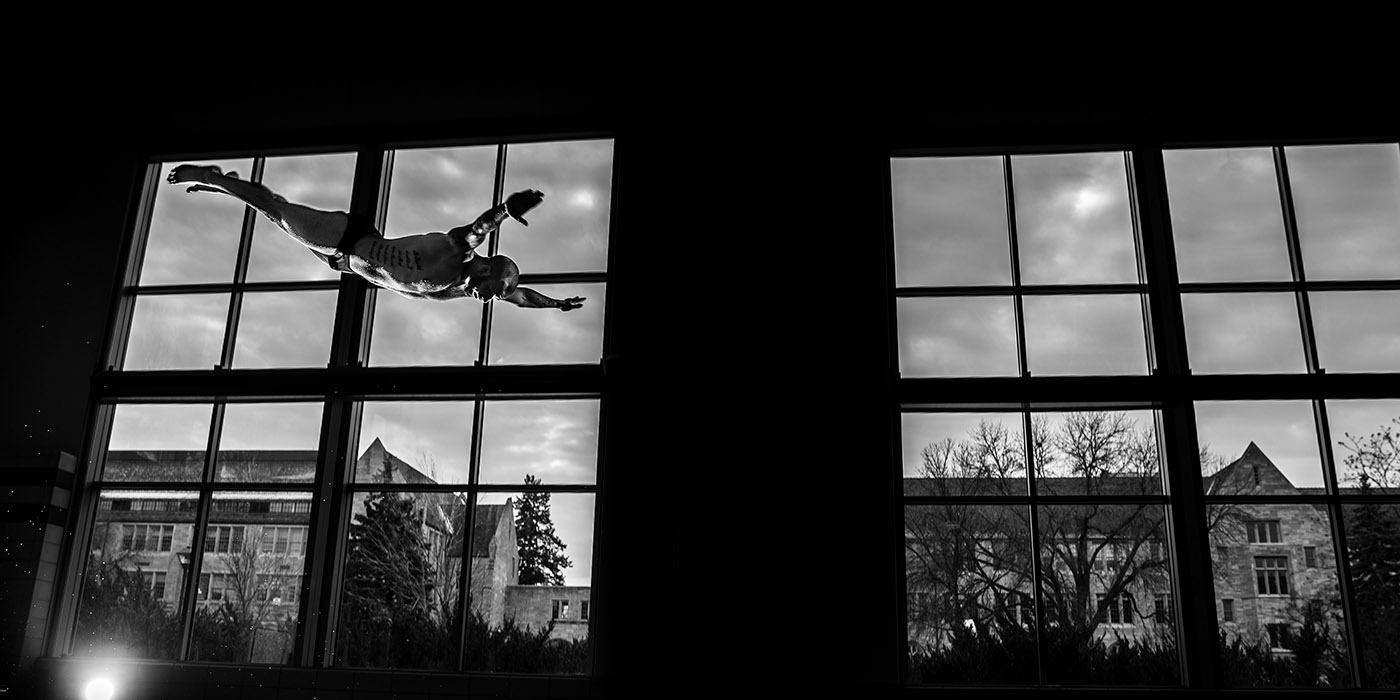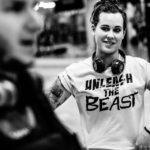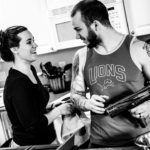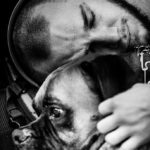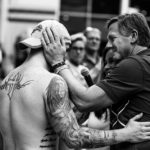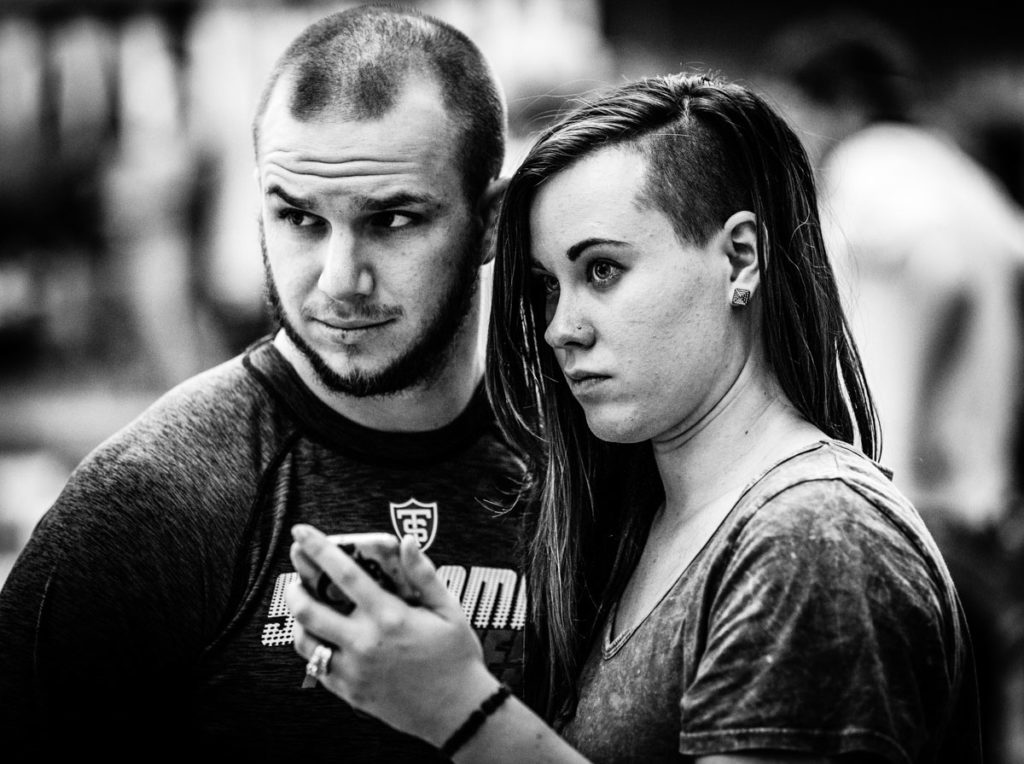Launched skyward by the diving board, Kyle Reid hits his jump’s apex. For a fleeting second, the world seems to stop.
He hears nothing. Sees nothing.
Peace.
Then gravity.
His chiseled, 25-year-old body plunges under water before he pulls himself to the surface.
Reid’s life is encapsulated in these series of seconds: a continuous and repetitive struggle, fighting upward against a force that always is waiting to pull him down. When it inevitably does, fighting again to rise.
“It’s a roller coaster,” his wife, Andee, said.
“It’s been the graph of sine,” said Reid, his head following the bobbing of his hand.
His story is a struggle of competing wills: the weight of a series of circumstances and events that have left him emotionally and physically wrecked, and a fiery resiliency that lifts him and spreads its light on everyone around. He is both those things, every moment of every day.
This is Kyle Reid.

Death in Afghanistan
Among a crowd of swimsuit-clad figures on the St. Thomas swimming and diving pool deck, Reid’s appearance demands attention: Sixteen tattoos cover his stocky, muscular frame – blacks and reds and oranges splashed across a canvas of skin. If that’s not enough, a 75-pound boxer dog is never far from Reid’s side.
These were the curiosities that led me to meet Reid, Andee, and their dog, Shamus, on a Wednesday afternoon last February in the Murray- Herrick Campus Center. Knowing nothing about him beforehand, I was shaken as, over two hours, the picture of a modern-day Job materialized in front of me, such were the depth and quantity of the trials he has faced. It seemed a miracle he was here to tell me about himself. Over the next nine months, how he lives life with the joy he does became more awe-inspiring.
Reid suffers from post-traumatic stress disorder and conversion disorder, a condition in which people show psychological stress in physical ways, all the results of a 2011 Marine tour in Afghanistan that marred him emotionally and mentally.
“I’m here physically, but to me I died in Afghanistan,” the Montana native said. “That’s where a big chunk of me is still at.”

Reid's Marine Corps dress blues.
A landing support specialist by training, Reid deployed in March 2011 and spent the first three months at Camp Dwyer in the Helmand Province before rotating to Camp Hansen. Not far from Marjah – where, the year before Reid arrived, the war’s largest joint operation to that point had taken place – Hansen sat in what remained a hot area for Taliban attack: Reid said two of his friends – one attacked by mortar fire inside the base and the other a Navy service member shot in the chest on patrol – died right before his eyes. The latter died in Reid’s arms as doctors desperately tried to stem the bleeding. Reid did everything he could to keep his friend conscious: talking to him about girls back in the states, sliding a guitar pick into his hand and encouraging him to focus on rubbing it.
“I started tapping the side of his face,” Reid said. “And he just wasn’t there anymore.”
On a base that regularly saw mortar, bullet and occasionally rocket fire, Reid loaded and unloaded helicopters. Early in his three-month station at Hansen, a sergeant major called for three volunteers; Reid’s hand shot up.
“He took us over to this 20-foot ISO container and said, ‘This is going to change your life forever,’” Reid said.
What they saw were the bodies of recently deceased military members. Those soldiers’ bodies – and the others that would continue to be brought there in the following months – needed to each be carried 350 yards to a landing zone where helicopters would transport them off base. Reid said, in retrospect, he knows that he essentially blacked out each trip. He would catch glimpses of reality afterward and realize he had been crying the whole way. In just over three months, he made that walk 32 times. Thirteen times no body bag was available.
Today, those 13 bodies are Reid’s constant reminder of what he endured. Shortly after returning to Camp Dwyer in October, he had his first hallucination: an omnipresence of one, two and sometimes three of those dead soldiers whose faces and bodies were burned into his brain and brought into his everyday life.
“Every step I take, every room I’m in, they’re here with me,” Reid said.

Reid carries a pair of shoes and a weighted vest down a hall of the Anderson Athletic and Recreation Complex. Reid wears the vest during his daily workout.
Reid still has hallucinations to this day, as well as insomnia, flashbacks and heightened stress levels. His conversion disorder manifests itself through seizures: sporadic instances that physically arrest Reid's body and send him collapsing to the ground. While feeling particularly stressed often can warn Reid of an impending seizure, there’s no real way to know when one will hit.
“It’s all lost time to me; I’ll have no recollection. I’ll be standing there one second and the next thing I know I’m on my back and there are five, 10, 20 people looking down at me wondering what’s wrong,” Reid said. “Afterward it feels like I’ve run a marathon.”
Part of how Reid has dealt with all the trauma in his life has been through tattoos, commemorating his grandmother, friends, fellow soldiers killed in Afghanistan and the two children he and Andee lost to miscarriage. None, though, has stood out so painfully on his skin and in his heart as his younger brother Jesse, who was killed last February in a collision with a semi on a Montana highway after qualifying for the state high school wrestling tournament as a senior. “I could cover my entire body in tattoos and not come close to signifying how special Jesse was,” Reid said. “I’ve never gone through anything as hard as [losing him].”

Kyle Reid at home.
Back home

The guitar pick, always carried in Reid's wallet.
While today Reid is honest, open and straightforward about everything he has experienced and deals with, his path to this point has been long. When he returned from Afghanistan at the end of 2011 he simply drowned himself in alcohol, desperately trying to battle alone the hallucinations and insomnia terrorizing him. With a gun in his mouth and ready to pull the trigger, he reached into his jean pocket and found that guitar pick from Afghanistan, which couldn’t save his friend but somehow found its way into another hand. Breaking down, Reid said he knew then, and has known since, he couldn’t force those who love him to deal with him taking his own life.
Despite pulling himself away from that brink, Reid still hid his PTSD from everyone when he returned to his base in California, where he continued serving after his overseas tour was complete. That included hiding symptoms from Andee, whom he married in February 2012. It wasn’t until Andee’s second miscarriage in July 2012, when Reid’s emotional response was nonexistent, that she knew something was absolutely wrong and they needed to seek professional help.
“We really did hit rock bottom,” Andee said.
Shortly afterward Reid started receiving combat counseling and was diagnosed with PTSD, the first step in a path toward acceptance and getting help. Andee, as Reid’s partner in marriage and in life, plays a vital role as a full-time caregiver who is with him at nearly all times.
“I do not know where I would be without her,” Reid said.
Reid was transferred into the Marine Corps Wounded Warrior Regiment, which “is committed to the recovery and success of Marines.” After his diagnosis Reid represented the Marines in both swimming as well as track and field in competition with wounded members from military branches of both the United States and other countries. Summer 2012 also saw the arrival of Shamus, a trained service dog. Shamus acts as a much-needed stress regulator and, during Reid’s seizures, lays his body against Reid and helps return his vitals to normal.

Kyle kisses Andee before the start of a swim meet.

Shamus and Reid watch the world outside Reid's St. Paul condo.
In summer 2013 Reid and Andee moved back to Montana, where Andee is also from and where the bulk of Reid’s huge extended family resides. (Reid grew up in Chinook, and his relatives make up a good chunk of the small town’s population; his great-grandmother was the youngest of 24 children and had 13 children of her own, Reid said.) Growing up with so many relatives, including three brothers (and four half sisters through his biological father), helped place family as a priority in Reid’s life.
“Family is simply the most important thing you can have,” Reid said.
A Minnesota family
While being geographically closer to family provided a foundation of support, Reid struggled in various ways to connect while attending school at Montana State University. Wanting to continue his education as a student athlete, he reached out to various schools and struck up a relationship with St. Thomas swimming and diving coach Scott Blanchard, who helped draw Reid to transfer in fall 2015 and enroll as a health and human performance major.
“One of the things we’re all about in the program is family. That’s a guiding principle of ours. He loved talking about that, hearing about that. He was starved for it, thirsty for it, wanted to dive in,” Blanchard said. “From day one he never hesitated. He made it pretty clear from the beginning he wanted to be fully a part of this.”
A shoulder injury derailed Reid’s plans to join the team as a swimmer, but teammates advised him to approach diving coach Mark Dusbabek, who was more than happy to help mold the raw, athletic Marine into a diver. With no formal diving experience Reid was one of the conference’s top divers by season’s end, and now into his junior year, he has improved even more. Reid’s experience with Dusbabek also speaks of the power of relationships: Dusbabek’s father, a former Marine and Vietnam veteran, passed away just before Reid arrived at St. Thomas. The friendship Reid and Dusbabek have developed is a huge source of healing for both men.
“He’s been there as much for me as I’ve been for him. That’s the kind of man he is,” Dusbabek said.

Dive coach Mark Dusbabek gives Reid a hug on the pool deck.

Divers psych up before a meet.
Dusbabek said Reid has “blossomed” in the team’s family-centered dynamic, emerging as not only a vocal and emotional leader but as an important, living testimony to the experience of military men and women who sacrifice so much.
“How he’s able to handle things in his life and live with these challenges that face him, it inspires me to do the same. To move forward from things and not give up. He really does show us that nothing is impossible,” sophomore diver Andrew Grabowski said. “It’s so inspirational to me and my teammates.”
Reid said the feeling of family within the team cemented itself on Veterans Day in 2015. At practice, all the swimmers and divers got out of the pool, hugged him, thanked him for his service and expressed how glad they were that he’s here with them. (The same scene played out again in 2016.) Since then, the relationships with his St. Thomas family only have grown stronger, helping build a community and daily life that Reid said has put him in the best place he's been since returning from Afghanistan.

Reid and fellow diver Andrew Grabowski laugh while waiting to dive.

Reid begins most dives by pointing up, in honor of his brother Jesse. “I have felt that my little brother is on the boards with me and helping me get through my dives. Essentially every dive I do is like a little tribute to him.”
Despite navigating his course load at St. Thomas amidst counseling sessions and everything surrounding the management of his PTSD, Reid has impressed faculty and classmates with his tenacious, goal-driven pursuit of an education. He hopes to use that education to become a personal trainer at a gym with his two older brothers in Arizona. In particular, he wants to work with veterans and share the benefits of physical activity that have been such a crucial element in his own life.
“I can’t say enough about him as a student. He’s taking advantage of everything he can, all these experiences here,” said HHP assistant professor Brett Bruininks, Reid’s academic adviser. “He knows exactly what he wants to be doing [with his education]. He could have gone a different path, but the fact he wants to go back and help veterans and help improve someone’s health and wellness, that’s pretty inspiring.”
“I feel I could help give people a purpose [as a personal trainer], those goals to work toward,” Reid added. “From my experiences of exercise, where I feel a lot of joy, relaxation, and when I finish a workout feeling accomplished, that’s part of what has kept me from the edge for so long. That and my family. Being able to pass that along to other veterans would be one of the best things that I could do.”
His constant giving of himself to others amazes those who know Reid and spend time around him, how – despite everything he deals with – he engages everyone with a smile, a hug, a corny joke that comes so naturally from his goofball personality. None of that comes easily, though; Reid makes a conscious decision each morning that he is going to get out of bed and do everything he can to make it a good day, even though he knows some days will bring more hardships than others. Throughout all this, Reid is never alone: Andee and Shamus are there with him, centering his life in love; his family members are never more than a phone call away; his lost friends and family are remembered on his skin and inside him; his teammates, coaches, teachers and friends at St. Thomas are here to support him; and a workout (or two, or three) is waiting each day to bring him the welcome focus of a task at hand. Of course, none of that can keep Reid in the air forever; the gravity of everything he has experienced is always there, ready to bring him down. But Reid has a lot of practice in rising back up.

Read more from St. Thomas magazine.
